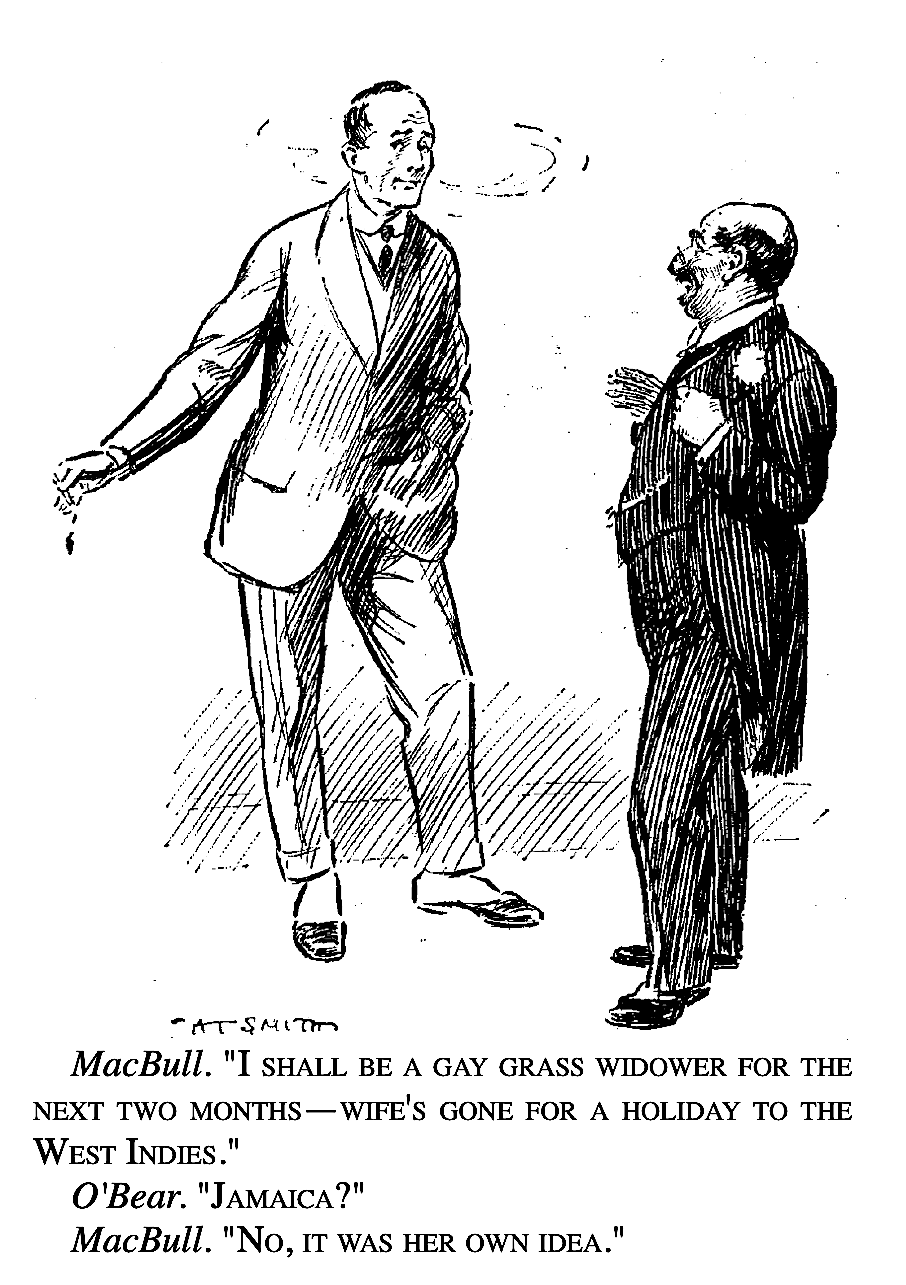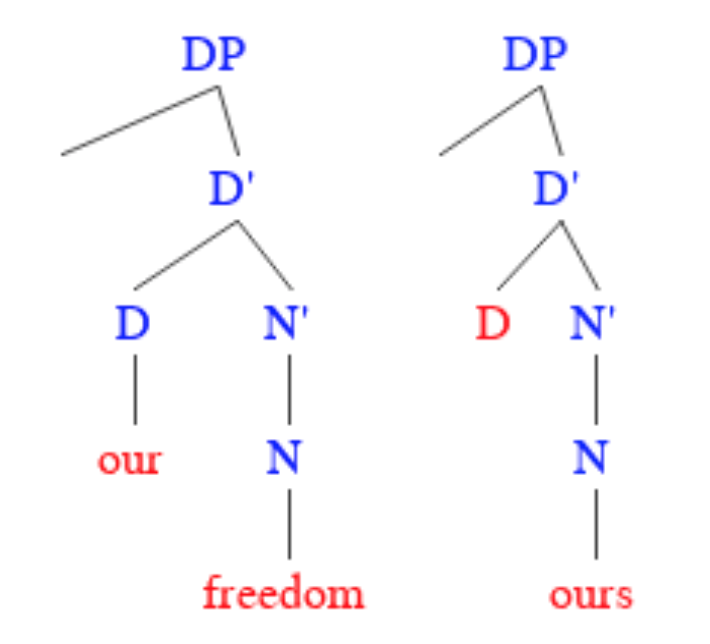|
Cataphora
In linguistics, cataphora (; from Greek, '' καταφορά'', ''kataphora'', "a downward motion" from '' κατά'', ''kata'', "downwards" and '' φέρω'', ''pherō'', "I carry") is the use of an expression or word that co-refers with a later, more specific expression in the discourse. The preceding expression, whose meaning is determined or specified by the later expression, may be called a cataphor. Cataphora is a type of anaphora, although the terms ''anaphora'' and ''anaphor'' are sometimes used in a stricter sense, denoting only cases where the order of the expressions is the reverse of that found in cataphora. An example of cataphora in English is the following sentence: * When he arrived home, John went to sleep. In this sentence, the pronoun ''he'' (the cataphor) appears earlier than the noun ''John'' (the postcedent) that it refers to. This is the reverse of the more normal pattern, "strict" anaphora, where a referring expression such as ''John'' (in the example a ... [...More Info...] [...Related Items...] OR: [Wikipedia] [Google] [Baidu] |
Anaphora (linguistics)
In linguistics, anaphora () is the use of an expression whose interpretation depends upon another expression in context (its antecedent). In a narrower sense, anaphora is the use of an expression that depends specifically upon an antecedent expression and thus is contrasted with cataphora, which is the use of an expression that depends upon a postcedent expression. The anaphoric (referring) term is called an anaphor. For example, in the sentence ''Sally arrived, but nobody saw her'', the pronoun ''her'' is an anaphor, referring back to the antecedent ''Sally''. In the sentence ''Before her arrival, nobody saw Sally'', the pronoun ''her'' refers forward to the postcedent ''Sally'', so ''her'' is now a ''cataphor'' (and an anaphor in the broader, but not the narrower, sense). Usually, an anaphoric expression is a pro-form or some other kind of deictic (contextually dependent) expression. Both anaphora and cataphora are species of endophora, referring to something mentioned elsew ... [...More Info...] [...Related Items...] OR: [Wikipedia] [Google] [Baidu] |
Coreference
In linguistics, coreference, sometimes written co-reference, occurs when two or more expressions refer to the same person or thing; they have the same referent. For example, in ''Bill said Alice would arrive soon, and she did'', the words ''Alice'' and ''she'' refer to the same person. Co-reference is often non-trivial to determine. For example, in ''Bill said he would come'', the word ''he'' may or may not refer to Bill. Determining which expressions are coreferences is an important part of analyzing or understanding the meaning, and often requires information from the context, real-world knowledge, such as tendencies of some names to be associated with particular species ("Rover"), kinds of artifacts ("Titanic"), grammatical genders, or other properties. Linguists commonly use indices to notate coreference, as in ''Billi said hei would come''. Such expressions are said to be ''coindexed'', indicating that they should be interpreted as coreferential. When expressions are corefer ... [...More Info...] [...Related Items...] OR: [Wikipedia] [Google] [Baidu] |
Endophora
Endophora refers to the phenomenon of expressions that derive their reference from something within the surrounding text (endophors). For example, in the sentences "I saw Sally yesterday. She was lying on the beach", "she" is an ''endophoric'' expression because it refers to something mentioned elsewhere in the text, i.e. "Sally". By contrast, "She was lying on the beach," if it appeared by itself, contains an ''exophoric'' expression; "she" refers to something that is not present in the surrounding text, so there is not enough information given within the text to independently determine to whom "she" refers. It can refer to someone the speaker assumes his audience has prior knowledge of, or it can refer to a person he is showing to his listeners. Without further information, in other words, there is no way of knowing the exact meaning of an exophoric term. Endophora can be broken into three subcategories: cataphora, anaphora and self-reference. See also * * * * * * Referen ... [...More Info...] [...Related Items...] OR: [Wikipedia] [Google] [Baidu] |
Pragmatics
In linguistics and the philosophy of language, pragmatics is the study of how Context (linguistics), context contributes to meaning. The field of study evaluates how human language is utilized in social interactions, as well as the relationship between the interpreter and the interpreted. Linguists who specialize in pragmatics are called pragmaticians. The field has been represented since 1986 by the International Pragmatics Association (IPrA). Pragmatics encompasses phenomena including implicature, speech acts, relevance theory, relevance and Conversation analysis, conversation,Mey, Jacob L. (1993) ''Pragmatics: An Introduction''. Oxford: Blackwell (2nd ed. 2001). as well as nonverbal communication. Theories of pragmatics go hand-in-hand with theories of semantics, which studies aspects of meaning, and syntax, which examines sentence structures, principles, and relationships. The ability to understand another speaker's intended meaning is called ''pragmatic competence''. In 1938 ... [...More Info...] [...Related Items...] OR: [Wikipedia] [Google] [Baidu] |
Figures Of Speech
A figure of speech or rhetorical figure is a word or phrase that intentionally deviates from straightforward language use or literal meaning to produce a rhetorical or intensified effect (emotionally, aesthetically, intellectually, etc.). In the distinction between literal and figurative language, figures of speech constitute the latter. Figures of speech are traditionally classified into '' schemes'', which vary the ordinary sequence of words, and '' tropes'', where words carry a meaning other than what they ordinarily signify. An example of a scheme is a polysyndeton: the repetition of a conjunction before every element in a list, whereas the conjunction typically would appear only before the last element, as in "Lions and tigers and bears, oh my!"—emphasizing the danger and number of animals more than the prosaic wording with only the second "and". An example of a trope is the metaphor, describing one thing as something it clearly is not, as a way to illustrate by compar ... [...More Info...] [...Related Items...] OR: [Wikipedia] [Google] [Baidu] |
Apposition
Apposition is a grammatical construction in which two elements, normally noun phrases, are placed side by side so one element identifies the other in a different way. The two elements are said to be ''in apposition'', and the element identifying the other is called the appositive. The identification of an appositive requires consideration of how the elements are used in a sentence. For example, in these sentences, the phrases ''Alice Smith'' and ''my sister'' are in apposition, with the appositive identified with italics: * My sister, ''Alice Smith'', likes jelly beans. * Alice Smith, ''my sister'', likes jelly beans. Traditionally, appositives were called by their Latin name ''appositio'', derived from the Latin ''ad'' ("near") and ''positio'' ("placement"), although the English form is now more commonly used. Apposition is a figure of speech of the scheme type and often results when the verbs (particularly verbs of being) in supporting clauses are eliminated to produce sho ... [...More Info...] [...Related Items...] OR: [Wikipedia] [Google] [Baidu] |
Colon (punctuation)
The colon, , is a punctuation mark consisting of two equally sized dots aligned vertically. A colon often precedes an explanation, a list, or a quoted sentence. It is also used between hours and minutes in time, between certain elements in medical journal citations, between chapter and verse in Bible citations, between two numbers in a ratio, and, in the US, for salutations in business letters and other formal letters. History In Ancient Greek, in rhetoric and prosody, the term (', 'limb, member of a body') did not refer to punctuation, but to a member or section of a complete thought or passage; see also ''Colon (rhetoric)''. From this usage, in palaeography, a colon is a clause or group of clauses written as a line in a manuscript.''Oxford English Dictionary'', 1st ed. "colon, ''n.2''" Oxford University Press (Oxford), 1891. In the 3rd century BC, Aristophanes of Byzantium is alleged to have devised a punctuation system, in which the end of such a was thought to occasi ... [...More Info...] [...Related Items...] OR: [Wikipedia] [Google] [Baidu] |
Noun Phrase
A noun phrase – or NP or nominal (phrase) – is a phrase that usually has a noun or pronoun as its head, and has the same grammatical functions as a noun. Noun phrases are very common cross-linguistically, and they may be the most frequently occurring phrase type. Noun phrases often function as verb subjects and objects, as predicative expressions, and as complements of prepositions. One NP can be embedded inside another NP; for instance, ''some of his constituents'' has as a constituent the shorter NP ''his constituents''. In some theories of grammar, noun phrases with determiners are analyzed as having the determiner as the head of the phrase, see for instance Chomsky (1995) and Hudson (1990) . Identification Some examples of noun phrases are underlined in the sentences below. The head noun appears in bold. ::This election-year's politics are annoying for many people. ::Almost every sentence contains at least one noun phrase. ::Current economic weakness may be a re ... [...More Info...] [...Related Items...] OR: [Wikipedia] [Google] [Baidu] |
Pronoun
In linguistics and grammar, a pronoun (Interlinear gloss, glossed ) is a word or a group of words that one may substitute for a noun or noun phrase. Pronouns have traditionally been regarded as one of the part of speech, parts of speech, but some modern theorists would not consider them to form a single class, in view of the variety of functions they perform cross-linguistically. An example of a pronoun is "you", which can be either singular or plural. Sub-types include personal pronoun, personal and possessive pronouns, reflexive pronoun, reflexive and reciprocal pronoun, reciprocal pronouns, demonstrative pronouns, relative pronoun, relative and interrogative pronouns, and indefinite pronouns. The use of pronouns often involves anaphora (linguistics), anaphora, where the meaning of the pronoun is dependent on an antecedent (grammar), antecedent. For example, in the sentence ''That poor man looks as if he needs a new coat'', the meaning of the pronoun ''he'' is dependent on its ... [...More Info...] [...Related Items...] OR: [Wikipedia] [Google] [Baidu] |
Referring Expression
In linguistics, a referring expression (RE) is any noun phrase, or surrogate for a noun phrase, whose function in discourse is to identify some individual object. The technical terminology for ''identify'' differs a great deal from one school of linguistics to another. The most widespread term is probably ''refer'', and a thing identified is a ''referent'', as for example in the work of John Lyons. In linguistics, the study of reference relations belongs to pragmatics, the study of language use, though it is also a matter of great interest to philosophers, especially those wishing to understand the nature of knowledge, perception and cognition more generally. Various devices can be used for reference including determiners, pronouns, proper names. Reference relations can be of different kinds; referents can be in a "real" or imaginary world, or in discourse itself, and they may be singular, plural, or collective. Kinds The kinds of expressions which can refer are: # a noun ... [...More Info...] [...Related Items...] OR: [Wikipedia] [Google] [Baidu] |
Linguistics
Linguistics is the scientific study of language. The areas of linguistic analysis are syntax (rules governing the structure of sentences), semantics (meaning), Morphology (linguistics), morphology (structure of words), phonetics (speech sounds and equivalent gestures in sign languages), phonology (the abstract sound system of a particular language, and analogous systems of sign languages), and pragmatics (how the context of use contributes to meaning). Subdisciplines such as biolinguistics (the study of the biological variables and evolution of language) and psycholinguistics (the study of psychological factors in human language) bridge many of these divisions. Linguistics encompasses Outline of linguistics, many branches and subfields that span both theoretical and practical applications. Theoretical linguistics is concerned with understanding the universal grammar, universal and Philosophy of language#Nature of language, fundamental nature of language and developing a general ... [...More Info...] [...Related Items...] OR: [Wikipedia] [Google] [Baidu] |



